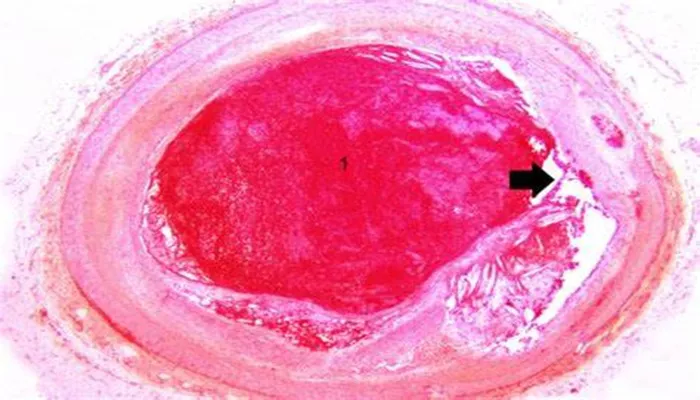Coronary thrombosis is a critical medical condition characterized by the formation of a blood clot within the coronary arteries, which supply blood to the heart muscle. This condition can lead to severe complications, including heart attacks and sudden cardiac death.
Understanding the causes of coronary thrombosis is essential for prevention and management. This article will delve into the various factors contributing to coronary thrombosis, emphasizing the underlying mechanisms and risk factors involved.
Causes of Coronary Thrombosis
Atherosclerosis
Atherosclerosis is the most common cause of coronary thrombosis. The process begins with endothelial injury, which can be caused by factors such as high blood pressure, smoking, and high cholesterol levels. This injury allows low-density lipoprotein (LDL) cholesterol to infiltrate the arterial wall, leading to plaque formation. When the plaque ruptures, it can create a site for thrombus formation, effectively blocking blood flow to the heart.
Coronary Artery Spasm
A coronary artery spasm is a temporary tightening of the muscles within the artery walls, which can restrict blood flow. This spasm can occur without warning and may be triggered by stress, smoking, or the use of certain drugs such as cocaine. In some cases, spasms can lead to thrombosis, especially in individuals with underlying atherosclerosis.
Intracardiac Thrombus
Blood clots can also form within the heart chambers, particularly in patients with certain heart conditions such as atrial fibrillation. When these clots dislodge, they can travel to the coronary arteries, causing a blockage and resulting in coronary thrombosis.
Coronary Artery Dissection
Spontaneous coronary artery dissection (SCAD) is a rare but serious condition where a tear forms in the artery wall. This can lead to the formation of a thrombus at the site of the tear, obstructing blood flow to the heart. SCAD is more common in women and can occur in individuals without traditional risk factors.
Inflammation of Blood Vessels
Vasculitis, or inflammation of the blood vessels, can also contribute to coronary thrombosis. Conditions such as lupus or rheumatoid arthritis can cause inflammation that damages the endothelial lining of the arteries, increasing the risk of clot formation.
SEE ALSO: How Long Can You Live with Unstable Angina?
Risk Factors
Several risk factors significantly increase the likelihood of developing coronary thrombosis:
Hypertension: High blood pressure can cause damage to the arterial walls, making them more susceptible to atherosclerosis and thrombus formation.
Hyperlipidemia: Elevated levels of cholesterol, particularly LDL, contribute to plaque buildup in the arteries, increasing the risk of rupture and thrombosis.
Smoking: Tobacco use damages blood vessels and promotes atherosclerosis, significantly increasing the risk of coronary thrombosis.
Diabetes: Poorly controlled diabetes can lead to vascular damage and increased clotting tendencies, making individuals more prone to coronary thrombosis.
Obesity: Excess weight contributes to hypertension, diabetes, and hyperlipidemia, all of which are risk factors for coronary thrombosis.
Family History: A family history of heart disease or thrombosis can indicate a genetic predisposition to these conditions.
Pathophysiology of Coronary Thrombosis
The pathophysiology of coronary thrombosis involves several interconnected processes, including endothelial injury, platelet activation, and coagulation cascade activation.
Endothelial Injury: The endothelium plays a crucial role in maintaining vascular health. Damage to this layer can lead to increased permeability, allowing lipids and inflammatory cells to infiltrate the arterial wall, promoting atherosclerosis.
Platelet Activation: When plaque ruptures, it exposes collagen and tissue factor to the bloodstream, triggering platelet activation.
Activated platelets adhere to the site of injury and release substances that promote further platelet aggregation and thrombus formation.
Coagulation Cascade: The coagulation cascade is a series of complex biochemical reactions that lead to the formation of fibrin, which stabilizes the platelet plug and forms a mature thrombus. Factors such as thrombin and fibrinogen play critical roles in this process.
Symptoms of Coronary Thrombosis
The symptoms of coronary thrombosis can vary widely but often include:
Chest Pain: Often described as a feeling of pressure or squeezing in the chest, which may radiate to the arms, neck, back, or jaw.
Shortness of Breath: Difficulty breathing or a feeling of breathlessness, which may occur at rest or during physical activity.
Nausea and Sweating: Many patients report feelings of nausea, along with cold sweats.
Lightheadedness or Dizziness: Some individuals may experience fainting or a sensation of impending doom.
Diagnosis And Treatment
Diagnosing coronary thrombosis typically involves a combination of clinical evaluation, electrocardiogram (ECG), and imaging studies such as coronary angiography.
Electrocardiogram (ECG): An ECG can identify changes in heart rhythm or signs of ischemia.
Coronary Angiography: This procedure allows visualization of the coronary arteries to detect blockages or thrombi.
Blood Tests: Certain biomarkers, such as troponin, can indicate heart muscle damage due to reduced blood flow.
Treatment Options
The treatment of coronary thrombosis aims to restore blood flow to the affected area of the heart. Common approaches include:
Medications:
Antiplatelet Agents: Aspirin and other antiplatelet medications help prevent further clotting.
Anticoagulants: Drugs such as heparin reduce the blood’s ability to clot, helping to manage existing thrombi.
Thrombolytics: These medications dissolve blood clots and are often used in acute settings.
Surgical Interventions:
Coronary Angioplasty and Stenting: A balloon is used to open the blocked artery, and a stent is placed to keep it open.
Coronary Artery Bypass Grafting (CABG): In severe cases, bypass surgery may be necessary to restore blood flow to the heart.
Conclusion
Coronary thrombosis is a serious condition that can have life-threatening consequences. Understanding its causes, risk factors, and underlying mechanisms is crucial for effective prevention and management. By addressing modifiable risk factors and seeking timely medical intervention, individuals can significantly reduce their risk of developing coronary thrombosis and improve their overall heart health.


